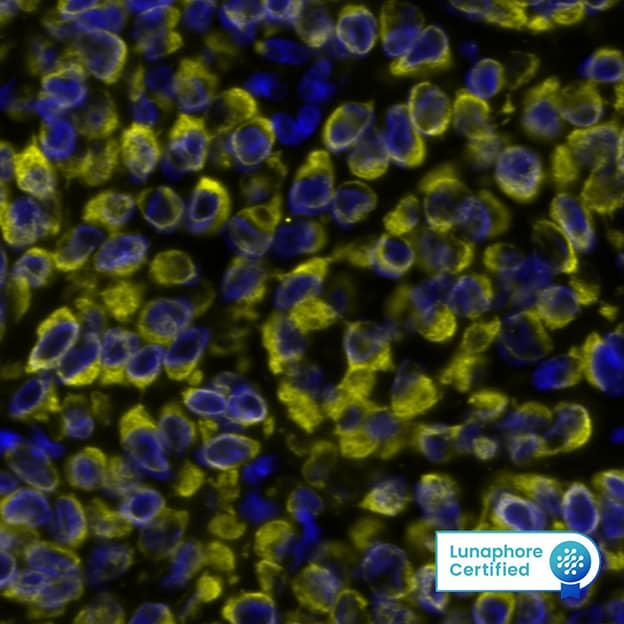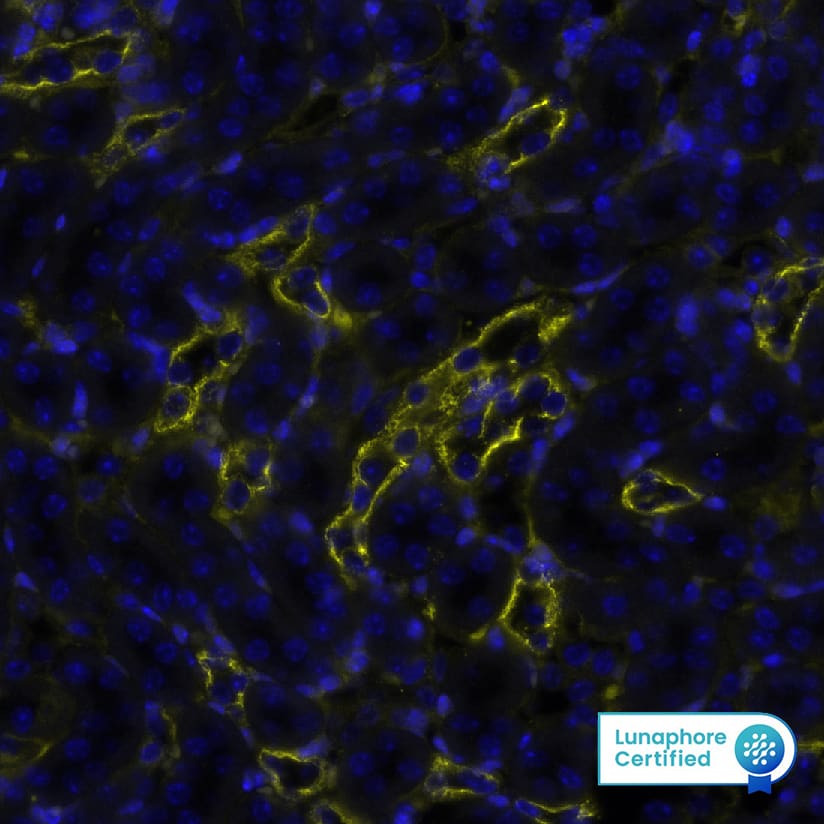Cytokeratin, pan Antibody (AE-1/AE-3) Best Seller
Novus Biologicals, part of Bio-Techne | Catalog # NBP2-29429


Conjugate
Catalog #
Forumulation
Catalog #
Key Product Details
Validated by
Orthogonal Validation
Species Reactivity
Validated:
Human, Mouse, Rat, Bovine, Canine, Chicken, Monkey, Rabbit, Reptile, Zebrafish
Cited:
Human, Mouse, Rat, Avian - Chicken, Bovine, Canine, Fish - Danio rerio (Zebrafish), Lizards
Applications
Validated:
CyTOF-reported, Dual RNAscope ISH-IHC, Flow (Intracellular), Flow Cytometry, Immunocytochemistry/ Immunofluorescence, Immunohistochemistry, Immunohistochemistry-Frozen, Immunohistochemistry-Paraffin, Multiplex Immunofluorescence, Single Cell Western, Western Blot
Cited:
Block/Neutralize, Flow Cytometry, IF/IHC, Immunocytochemistry, Immunocytochemistry/ Immunofluorescence, Immunohistochemistry, Immunohistochemistry-Frozen, Immunohistochemistry-Paraffin, Western Blot
Label
Unconjugated
Antibody Source
Monoclonal Mouse IgG1 Kappa/IgG1 Kappa Clone # AE-1/AE-3
Concentration
0.2 mg/ml
Product Specifications
Immunogen
Human epidermal keratin
Reactivity Notes
Reptile reactivity reported in scientific literature (PMID: 11351328). Zebrafish reactivity reported in scientific literature (PMID: 30970016).
Localization
Cytoplasmic
Specificity
Twenty human keratins are resolved with two-dimensional gel electrophoresis into acidic (pI 6.0) subfamilies. This antibody cocktail recognizes acidic (Type I or LMW) and basic (Type II or HMW) cytokeratins, which 67kDa (CK1); 64kDa (CK3); 59kDa (CK4); 58kDa (CK5); 56kDa (CK6); 52kDa (CK8); 56.5kDa (CK10); 50kDa (CK14); 50kDa (CK15); 48kDa (CK16); 40kDa (CK19). Many studies have shown the usefulness of keratins as markers in cancer research and tumor diagnosis. AE-1/AE-3 is a broad spectrum anti pan-cytokeratin antibody cocktail, which differentiates epithelial tumors from non-epithelial tumors e.g. squamous vs. adenocarcinoma of the lung, liver carcinoma, breast cancer, and esophageal cancer. It has been used to characterize the source of various neoplasms and to study the distribution of cytokeratin containing cells in epithelia during normal development and during the development of epithelial neoplasms. This antibody stains cytokeratins present in normal and abnormal human tissues and has shown high sensitivity in the recognition of epithelial cells and carcinomas.
Marker
Epithelial Marker
Clonality
Monoclonal
Host
Mouse
Isotype
IgG1 Kappa/IgG1 Kappa
Description
200ug/ml of antibody purified from Bioreactor Concentrate by Protein A or G. Prepared in 10 mM PBS with 0.05% BSA & 0.05% azide. Also available WITHOUT BSA & azide at 1.0 mg/ml. (NBP2-33200)
Antibody with azide - store at 2 to 8C. Antibody without azide - store at -20 to -80C.
Antibody with azide - store at 2 to 8C. Antibody without azide - store at -20 to -80C.
Scientific Data Images for Cytokeratin, pan Antibody (AE-1/AE-3)
Detection of pan-Cytokeratin in Human Breast via Multiplex Immunofluorescence staining on COMET™
Pan-Cytokeratin was detected in immersion fixed paraffin-embedded sections of human Breast Tumor using Mouse Anti-Human Cytokeratin, pan Monoclonal Antibody (Catalog # NBP2-29429) at 1:500 at 37 ° Celsius for 4 minutes. Before incubation with the primary antibody, tissue underwent an all-in-one dewaxing and antigen retrieval preprocessing using PreTreatment Module (PT Module) and Dewax and HIER Buffer H (pH 9; Epredia Catalog # TA-999-DHBH). Tissue was stained using the Alexa Fluor™ 555 Goat anti-Mouse IgG Secondary Antibody at 1:100 at 37 ° Celsius for 2 minutes. (Yellow; Lunaphore Catalog # DR555MS) and counterstained with DAPI (blue; Lunaphore Catalog # DR100). Specific staining was localized to the cytoplasm. Protocol available in COMET™ Panel Builder.Detection of Cytokeratin, pan in Mouse Kidney via seqIF™ staining on COMET™
Cytokeratin, pan was detected in immersion fixed paraffin-embedded sections of mouse Kidney using Mouse Anti-Human/Mouse Cyokeratin, pan Monoclonal Antibody (Catalog #NBP2-29429) at 1:200 dilution at 37 ° Celsius for 4 minutes. Before incubation with the primary antibody, tissue underwent an all-in-one dewaxing and antigen retrieval preprocessing using PreTreatment Module (PT Module) and Dewax and HIER Buffer H (pH 9; Epredia Catalog # TA-999-DHBH).Tissue was stained using the Alexa Fluor™ 647 Goat anti-Mouse IgG Secondary Antibody at 1:200 at 37 ° Celsius for 2 minutes. (Yellow; Lunaphore Catalog # DR647MS) and counterstained with DAPI (blue; Lunaphore Catalog # DR100). Specific staining was localized to the membrane. Protocol available in COMET™ Panel Builder.Detection of Cytokeratin, pan in Human Tissue in Dual RNAscope ISH-IHC
FFPE tissue sections of human metastatic tonsil were probed for Pan Cytokeratin mRNA (ACD RNAScope probe, catalog # 310221; Fast Red chromogen, ACD catalog # 322500). Adjacent tissue section was processes for IHC using mouse monoclonal antibody (Novus catalog # NBP2-29429) at 0.3 ug/mL for 1 hour at room temperature followed by incubation with the anti-mouse IgG VisUCyte HRP Polymer Antibody (Novus Catalog # VC001) and DAB chromogen (yellow-brown). Tissue was counterstained with hematoxylin (blue).Applications for Cytokeratin, pan Antibody (AE-1/AE-3)
Application
Recommended Usage
Flow Cytometry
1-2 ug/million cells
Immunocytochemistry/ Immunofluorescence
1-2 ug/ml
Immunohistochemistry-Frozen
0.5-1.0ug/ml
Immunohistochemistry-Paraffin
0.25-0.5 ug/ml
Multiplex Immunofluorescence
1:200 - 1:500
Single Cell Western
1:10
Western Blot
1-2 ug/ml
Application Notes
Use in ICC/IF reported in scientific literature (PMID:34376789)
Immunohistochemistry (Formalin-fixed): 0.25-0.5ug/ml for 30 min at RT. Staining of formalin-fixed tissues requires heating tissue sections in 10mM Tris with 1mM EDTA, pH 9.0, for 45 min at 95C followed by cooling at RT for 20 minutes.
Optimal dilution for a specific application should be determined.
Western Blot: 1-2ug/ml for 2 hours at RT.
The staining pattern of the pan cytokeratin antibody cocktail may be different than that of either antibody separately.
This antibody cocktail recognizes acidic (Type I or LMW) and basic (Type II or HMW) cytokeratins, which 67 kDa (CK1) ; 64 kDa (CK3) ; 59 kDa (CK4) ; 58 kDa (CK5) ; 56 kDa (CK6) ; 52 kDa (CK8) ; 56.5 kDa (CK10) ; 50k Da (CK14) ; 50 kDa (CK15) ; 48 kDa (CK16) ; 40 kDa (CK19) . The pan cytokeratin cocktail does not react with keratin 18, which is also expressed in carcinomas. As such, negative staining with NBP2-29429 in of itself may not be sufficient evidence to rule out the possibility of a carcinoma (Ordonez, 2013) .
For example, hepatocellular, adrenal cortical, clear cell renal and chromophobe renal cell carcinomas have been reported to be negative for the pan cytokeratin antibody. In this regard, the pan cytokeratin antibody can be used as part of a screening panel to more extensively define the tumor cell lineages.
The pan cytokeratin antibody may cross-react with GFAP, leading to aberrant positive staining of glial tumors such as ependymoma, glioblastoma, or schwannoma (Ordonez, 2013) . Use in Immunohistochemistry reported in scientific literature (PMID: 29169625) . This Cytokeratin, pan Antibody (AE-1/AE-3) is validated for CyTOF from a verified customer review.
Immunohistochemistry (Formalin-fixed): 0.25-0.5ug/ml for 30 min at RT. Staining of formalin-fixed tissues requires heating tissue sections in 10mM Tris with 1mM EDTA, pH 9.0, for 45 min at 95C followed by cooling at RT for 20 minutes.
Optimal dilution for a specific application should be determined.
Western Blot: 1-2ug/ml for 2 hours at RT.
The staining pattern of the pan cytokeratin antibody cocktail may be different than that of either antibody separately.
This antibody cocktail recognizes acidic (Type I or LMW) and basic (Type II or HMW) cytokeratins, which 67 kDa (CK1) ; 64 kDa (CK3) ; 59 kDa (CK4) ; 58 kDa (CK5) ; 56 kDa (CK6) ; 52 kDa (CK8) ; 56.5 kDa (CK10) ; 50k Da (CK14) ; 50 kDa (CK15) ; 48 kDa (CK16) ; 40 kDa (CK19) . The pan cytokeratin cocktail does not react with keratin 18, which is also expressed in carcinomas. As such, negative staining with NBP2-29429 in of itself may not be sufficient evidence to rule out the possibility of a carcinoma (Ordonez, 2013) .
For example, hepatocellular, adrenal cortical, clear cell renal and chromophobe renal cell carcinomas have been reported to be negative for the pan cytokeratin antibody. In this regard, the pan cytokeratin antibody can be used as part of a screening panel to more extensively define the tumor cell lineages.
The pan cytokeratin antibody may cross-react with GFAP, leading to aberrant positive staining of glial tumors such as ependymoma, glioblastoma, or schwannoma (Ordonez, 2013) . Use in Immunohistochemistry reported in scientific literature (PMID: 29169625) . This Cytokeratin, pan Antibody (AE-1/AE-3) is validated for CyTOF from a verified customer review.
Reviewed Applications
Read 1 review rated 4 using NBP2-29429 in the following applications:
Formulation, Preparation, and Storage
Purification
Protein A or G purified
Formulation
10 mM PBS with 0.05% BSA
Preservative
0.05% Sodium Azide
Concentration
0.2 mg/ml
Shipping
The product is shipped with polar packs. Upon receipt, store it immediately at the temperature recommended below.
Stability & Storage
Store at 4C.
Background: Cytokeratin, pan
Epithelial cells express multiple subtypes of cytokeratins which can be used to classify epithelial cell type or differentiation status, as well tumor progression or diagnosis (2). Cytokeratins are important for both stability and integrity of epithelial cells and function in intracellular signaling, from wound healing to apoptosis (1). Cytokeratins are useful immunohistochemistry tumor markers and antibodies to cytokeratins are a common pathological tool (1,3,6). Cytokeratin pan antibody is an antibody cocktail mixture that can detect multiple cytokeratins and reacts to multiple epithelial tissues (1,3,6). For example, AE-1/AE-3 is a commonly used specific pan cytokeratin that detects cytokeratins 1-8, 10, 14-16 and 19 (1,3,6).
Given the role of cytokeratins in the structural integrity of epithelial cells, mutations in cytokeratins have been shown to play a role in a variety of human diseases including epidermolysis bullosa simplex (EBS) (4,5). EBS is an autosomal dominant disorder that is caused by missense mutations in either CK5 or CK14 (5). Other known cytokeratin-related disorders include bullous ichthyosis, a skin disorder characterized by redness, blistering, and hyperkeratosis, and epidermolytic palmoplantar keratoderma (EPPK), which results in hyperkeratosis on the palms and soles of the body (7).
References
1. Awasthi, P., Thahriani, A., Bhattacharya, A., Awasthi, P., & Keratins, B. A. (2016). Keratins or cytokeratins: a review article. Journal of Advanced Medical and Dental Sciences Research. https://10.21276/jamdsr.2016.4.4.30
2. Southgate, J., Harnden, P., & Trejdosiewicz, L. K. (1999). Cytokeratin expression patterns in normal and malignant urothelium: a review of the biological and diagnostic implications. Histology and histopathology. https://doi.org/10.14670/HH-14.657
3. Belaldavar, C., Mane, D. R., Hallikerimath, S., Kale, A. D. (2016). Cytokeratins: Its role and expression profile in oral health and disease. Journal of Oral and Maxillofacial Surgery, Medicine, and Pathology. https://doi.org/10.1016/j.ajoms.2015.08.001.
4. Linder S. (2007). Cytokeratin markers come of age. Tumour biology : the journal of the International Society for Oncodevelopmental Biology and Medicine. https://doi.org/10.1159/000107582
5. Jacob, J. T., Coulombe, P. A., Kwan, R., & Omary, M. B. (2018). Types I and II Keratin Intermediate Filaments. Cold Spring Harbor perspectives in biology. https://doi.org/10.1101/cshperspect.a018275
6. Ordonez N. G. (2013). Broad-spectrum immunohistochemical epithelial markers: a review. Human pathology. https://doi.org/10.1016/j.humpath.2012.11.016
7. McLean, W. H., & Moore, C. B. (2011). Keratin disorders: from gene to therapy. Human molecular genetics. https://doi.org/10.1093/hmg/ddr379
Alternate Names
AEI2, CK1, EHK, EPPK, K1, KRT1A, NEPPK
Gene Symbol
KRT1
UniProt
Additional Cytokeratin, pan Products
Product Documents for Cytokeratin, pan Antibody (AE-1/AE-3)
Product Specific Notices for Cytokeratin, pan Antibody (AE-1/AE-3)
This product is for research use only and is not approved for use in humans or in clinical diagnosis. Primary Antibodies are guaranteed for 1 year from date of receipt.
Loading...
Loading...
Loading...
Loading...
Loading...
Loading...







![Flow Cytometry: Cytokeratin, pan Antibody (AE-1/AE-3) [NBP2-29429] - Cytokeratin, pan Antibody (AE-1/AE-3)](https://resources.bio-techne.com/images/products/nbp2-29429_mouse-monoclonal-cytokeratin-pan-antibody-ae-1-ae-3-imgenex-nbo-135a-20ug-17720249362612.jpg)
![Flow Cytometry: Cytokeratin, pan Antibody (AE-1/AE-3) [NBP2-29429] - Cytokeratin, pan Antibody (AE-1/AE-3)](https://resources.bio-techne.com/images/products/nbp2-29429_mouse-monoclonal-cytokeratin-pan-antibody-ae-1-ae-3-imgenex-nbo-135a-20ug-17720241003217.jpg)
![Flow Cytometry: Cytokeratin, pan Antibody (AE-1/AE-3) [NBP2-29429] - Cytokeratin, pan Antibody (AE-1/AE-3)](https://resources.bio-techne.com/images/products/nbp2-29429_mouse-monoclonal-cytokeratin-pan-antibody-ae-1-ae-3-imgenex-nbo-135a-20ug-1772024944230.jpg)